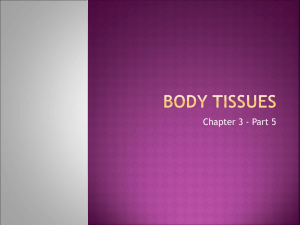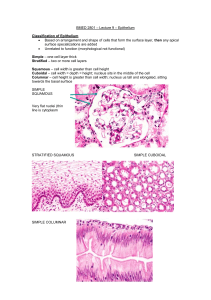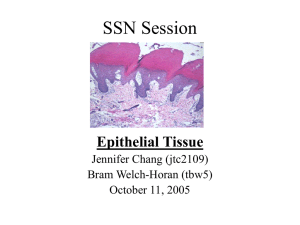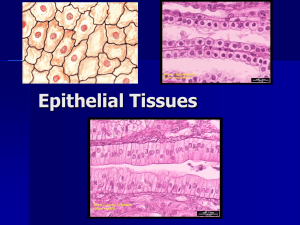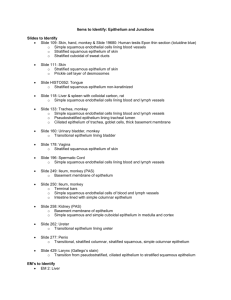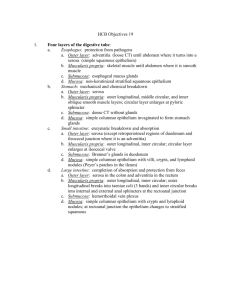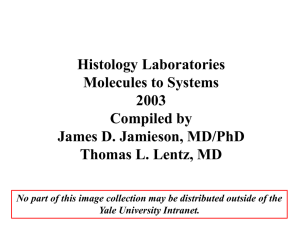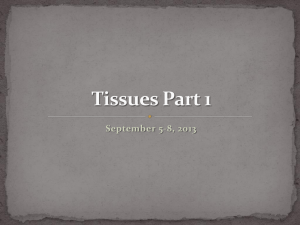Epithelial Tissue Powerpoint
advertisement
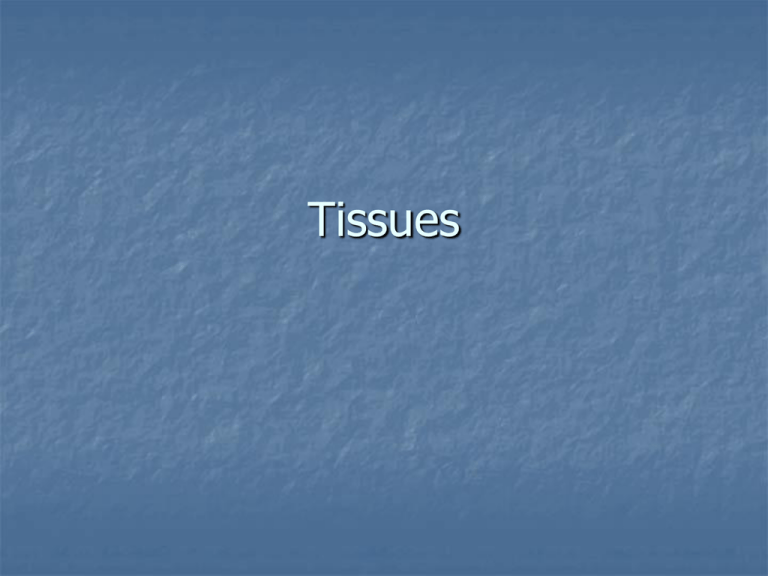
Tissues Tissue A group of similar cells, usually of similar embryonic origin, that function together to carry out specialized activities Histology The science that deals with the study of tissues Pathologist – a scientist who specializes in laboratory studies of cells and tissues to make accurate diagnoses. A pathologist examines tissues for any changes that might indicate disease. Types of Tissues Epithelial Tissue Connective Tissue protect and supports the body and its organs, binds organs together, stores energy reserves as fat, provides immunity Muscular Tissue Covers body surfaces; lines body cavities, hollow organs and ducts; forms glands Generates the force needed to make body structures move Nervous Tissue Detects changes inside and outside the body and initiates and transmits nerve impulses that coordinate body activities to help maintain homeostasis Cell Junctions Points of contact between plasma membranes of different cells that join them into functional units. Epithelial Tissue AKA Epithelium 2 types: Covering and Lining Epithelium Forms the outer covering of the skin and some internal organs. It also lines body cavities, blood vessels, ducts, and the interiors of many of the body systems. Glandular Epithelium Makes the secreting portion of glands General Features of Epithelium 1. Closely packed cells with little extracellular material between them arranged in sheets 2. Surfaces: Apical Surface – exposed to a body cavity, the outside of the body or lining an internal organ Lateral Surface – Face adjacent cells Basal Surface – bottom layer attached to a basement membrane (extracellular structure composed mainly of fibers located between epithelium and underlying connective tissue) General Features of Epithelium 3. Avascular – no blood vessels. Epithelial cells must get their nutrients from underlying connective tissue through diffusion 4. Innervated (have a nerve supply) 5. High mitotic rate – high capacity for cell division because of wear and tear and injury Covering and Lining Epithelium – Cell Shapes Squamous – flat cells that attach to each other like tiles Cuboidal – cells are as tall as they are wide, sometimes contain microvilli Function in Secretion and Absorption Columnar – Taller than they are wide, sometimes contain microvilli or cilia Allows for rapid passage of substances through them Function in Secretion, Absorption and Protection Transitional – Cells that have the ability to change shape from Cuboidal to Squamous and back as organs stretch Simple Epithelium A single layer of cells found in areas where diffusion, osmosis, filtration, secretions and absorption occur Simple Squamous Epithelium A single layer of flat cells that resembles a tile floor when viewed from the apical surface Nucleus is a flattened oval found in the center of the cell Found where filtration or diffusion take place, not found in areas of high wear and tear Simple Squamous Epithelium Endothelium – simple squamous that lines the heart, blood vessels and lymphatic vessles Mesothelium – simple squamous that lines serous membranes (lines cavities not open to the outside of the body, like the abdomen or thorax) Simple Cuboidal Epithelium Single layer of cube shaped cells Found on the surface of the ovary, the lens of the eye and lining of glands as well as the secreting portion of glands Function in Secretion and Absorption Simple Columnar Epithelium Single Layer of Column Shaped Cells 2 Forms – cilliated and noncilliated Non-cilliated Simple Columnar Epithelium Contains absorptive cells and goblet cells Absorptive Cells – have microvilli to increase surface area Goblet Cells – modified Columnar cells that secrete mucus at the apical surface Lines most of the GI tract, ducts of glands and gallbladder Ciliated Simple Columnar Epithelium Cells with cilia at the apical surface, usually interspersed with goblet cells Mucus secreted by goblet cells forms a thin layer over the cell surface which is moved by the ciliated cells. Found in the respiratory tract Stratified Epithelium Contains 2 or more layers of cells used for protection of underlying tissue in area where there is a lot of wear and tear The name of the tissue depends on the shape of the cell on the apical layer Stratified Squamous Epithelium Cells in the apical layer are flat Cells in the deep layers vary in shape Basal cells continuously undergo mitosis As they move farther from the basal layer they become dehydrated and harder Keratinized Stratified Squamous Epithelium Tough layer of keratin is deposited on the top layers to help protect the skin and underlying tissues from microbes, heat and chemicals Nonkeratinized Stratified Squamous Epithelium Does not contain keratin Found on the lining of the mouth, esophagus, and tongue Stratified Cuboidal Epithelium Fairly Rare 2 or more layers of cells, apical layer is cuboidal Found in sweat glands Stratified Columnar Epithelium Fairly Rare 2 or more layers of cells, the top layer is columnar Found in excretory ducts of some glands and some mucous membranes Transitional Epithelium Varies in appearance depending on whether the organ it lines is distended or relaxed. Looks similar to stratified cuboidal except the top layer is large and rounded Pseudostratified Columnar Epithelium Appears to have several layers because the nuclei of the cells are at various depths. All of the cells are attached to the same basement membrane so there is only 1 layer of cells Glandular Epithelium Functions in Secretion A gland consists of one cell or a group of cells Endocrine Glands – secretions enter the interstitial fluid Hormones Exocrine Glands – secrete their products into ducts (tubes) that empty at the surface of the covering/lining epithelium Mucus, oil, earwax, digestive enzymes

